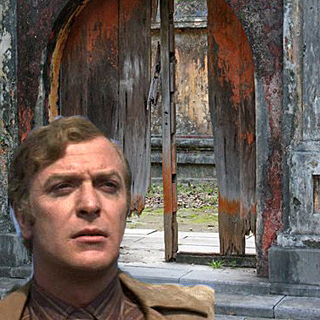 We’re not going to mention the weather. What is there to say that we haven’t said already this winter, after all? Suffice to say, we are fed up with it, as no doubt you are. The final indignity came last week when, in the paraphrased words of Michael Caine, the wind literally blew the bl**dy doors off at Pengelly. Luckily it was overnight so no one was hurt, but given those doors have been there 20 years, it puts into sharp perspective what we have faced this winter. Be careful out there.
We’re not going to mention the weather. What is there to say that we haven’t said already this winter, after all? Suffice to say, we are fed up with it, as no doubt you are. The final indignity came last week when, in the paraphrased words of Michael Caine, the wind literally blew the bl**dy doors off at Pengelly. Luckily it was overnight so no one was hurt, but given those doors have been there 20 years, it puts into sharp perspective what we have faced this winter. Be careful out there.
Let us move onto something more gentle, to soothe our furrowed brows. Winter scent. There is a temptation to think that once New Year has passed, we are heading back into spring. Not a bit of it; we are firmly in winter, but there are some advantages to that, and one of those is winter scent.
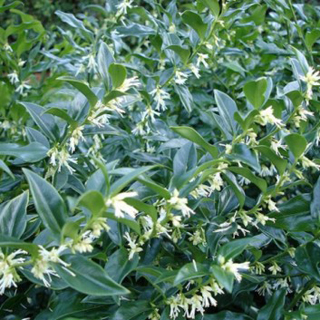 As we scuttle to and from the house at speed, there are plants at even this time of year that can stop you in your tracks, not with how it looks, but how it smells. One of those is sarcococca, also known as Sweet or Christmas box. Its flowers are tiny and almost inconsequential to look at, but the scent is a heady cloud of joy, which is a great lifter of spirits. It is a tame plant, easy to grow in a damp and slightly shady spot, and it behaves in terms of its habit.
As we scuttle to and from the house at speed, there are plants at even this time of year that can stop you in your tracks, not with how it looks, but how it smells. One of those is sarcococca, also known as Sweet or Christmas box. Its flowers are tiny and almost inconsequential to look at, but the scent is a heady cloud of joy, which is a great lifter of spirits. It is a tame plant, easy to grow in a damp and slightly shady spot, and it behaves in terms of its habit.
There are a few varieties available, many with a glossy dark green leaf, but one called Winter Gem with a more upright habit and a dusty pink tinge to its foliage and flower. Plant one of these where you will pass it at this tie of year and you will not be disappointed. The added joy is this is one plant where the scent comes to you – no need for bending down low. It wafts to you on the lightest of breezes and makes a great cut flower too.
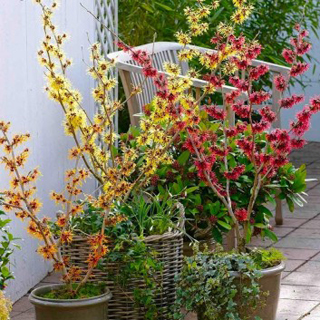 Similarly in flower at the moment is Hamamelis, otherwise known as witchhazel. Again, the flower is not big and blousy, but a collection of uneven strands ranging from acid yellow to burnt red, depending on the variety. On leafless stems, it burns bright, and if you get up close, the reward is a lovely spicy whiff. After flowering, the leaves will come and while green all summer, will give you a blast of autumn colour as they fade through to yellow, orange, red and rust before falling in the late autumn. It is a slow growing small tree, so great for a small garden or in a big pot.
Similarly in flower at the moment is Hamamelis, otherwise known as witchhazel. Again, the flower is not big and blousy, but a collection of uneven strands ranging from acid yellow to burnt red, depending on the variety. On leafless stems, it burns bright, and if you get up close, the reward is a lovely spicy whiff. After flowering, the leaves will come and while green all summer, will give you a blast of autumn colour as they fade through to yellow, orange, red and rust before falling in the late autumn. It is a slow growing small tree, so great for a small garden or in a big pot.
Coming up on the rails are a couple of more exotic plants that you might like to try. The first is a winter-flowering clematis called clematis napaulensis. This can be a confusing plant if you are used to the more common summer flowering clematis. The first thing is, in the height of summer, when everything else around the garden is looking lush and green, this plant’s leaves will shrivel and drop. Fear not, this is normal.
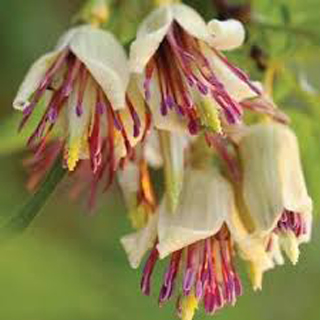
Leaves will start to emerge again around December time, in readiness for the plant to flower from about February onwards. It has a gentle scent from its clumps of small, bell-shaped flowers with jazzy pinky purple innards, but more importantly, is a valuable food source for any flying insects about and about early doors. Subtle to look at, so much more so than the blousy summer specimens.
And if you have a sheltered spot, consider an edgeworthia chrysantha. It’s a bit of an investment plant, although they are coming down in price. Emanating from the Chinese hills, it is perfectly frost-hardy, in spite of its delicate appearance. It just doesn’t like being in strong winds, salty or otherwise, so protection by other shrubs and trees is a must. However, the rewards are great as the scent is magnificent, and its shape is elegance personified (plantified?). We realise many folk are not keen on yellow, but there are now orangey-red cultivars available too, so don’t dismiss it out of hand.
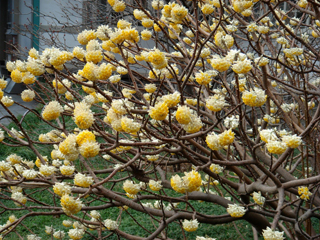
And if you don’t want to or don’t have the means to make such a big investment, look at skimmia, daphne and viburnum of all sorts – there are a dozen, for all situations and requirements. The garden centres are full of all these plants now, and if you get them in soon, (once we’re no longer waterlogged of course) you will realise this time next year that winter scent is one of the best things you can introduce to your garden. Go on, wake up and smell the coffee.
Sarah Daniel and Helen Robins, Pengelly Garden Centre
www.pengellygardencentre.co.uk

